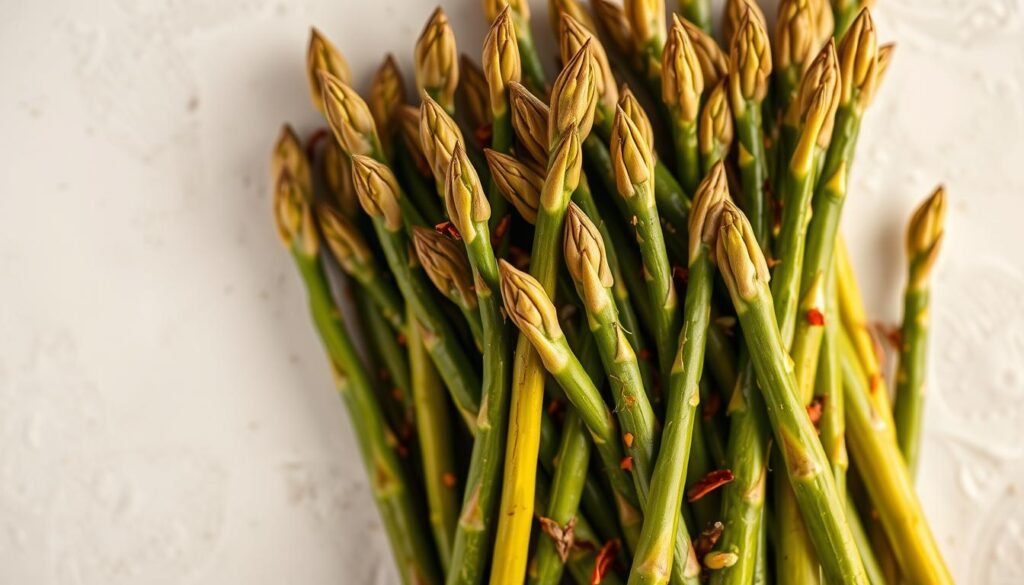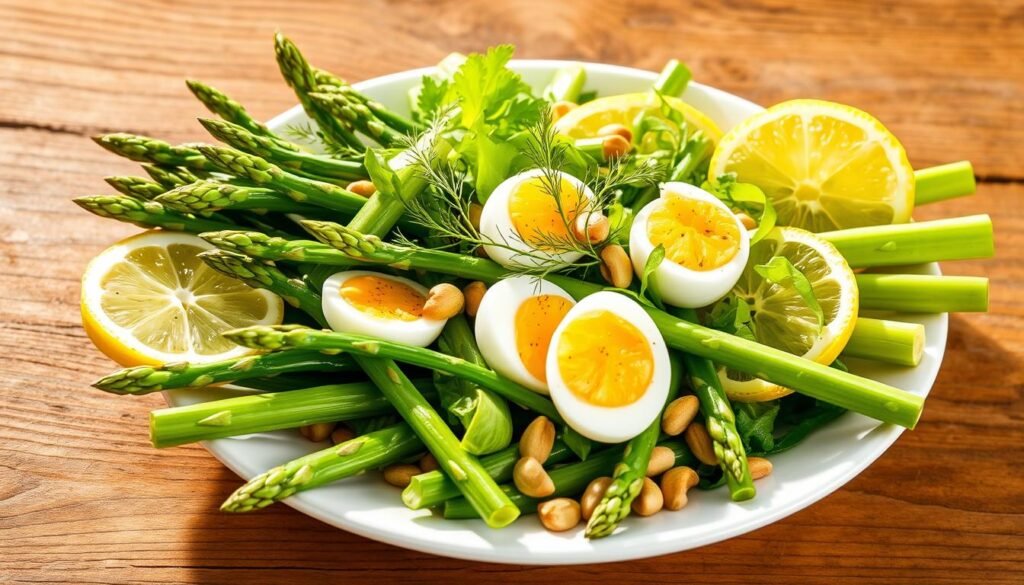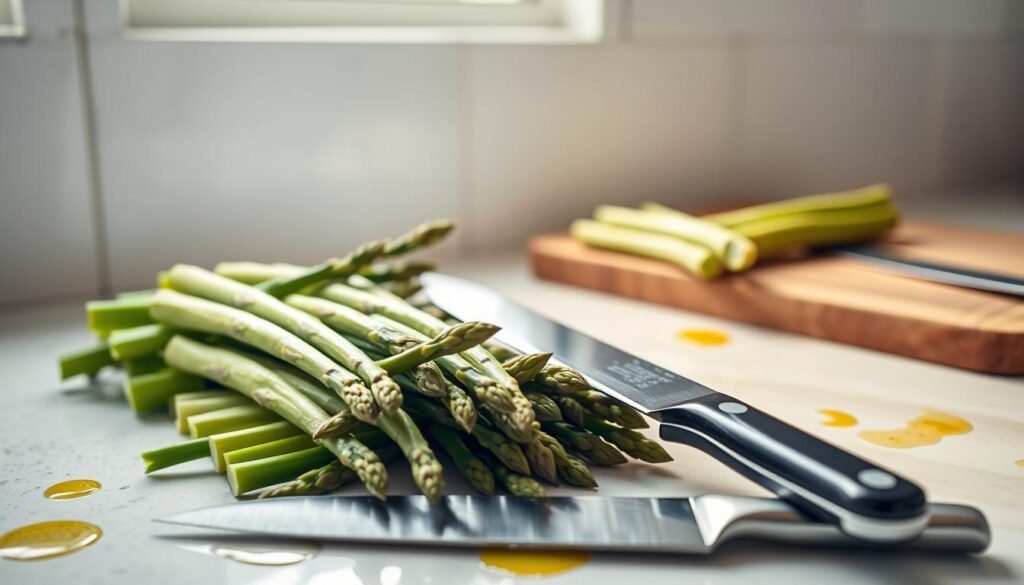Did you know asparagus is a gourmet delight and packed with nutrients? A single serving gives you over 60% of your daily vitamin K. It’s also very low in calories. This veggie can make your meals special, and I’m excited to share how to cook it.
In this guide, you’ll learn key tips for cooking asparagus. Whether you’re steaming, roasting, or grilling, you’ll get perfect results. Impress your loved ones with asparagus’s delicious versatility!
Key Takeaways
- Asparagus is rich in vitamins and nutrients, making it a healthy addition to your meals.
- Understanding different cooking methods enhances the flavor and texture of asparagus.
- Simple seasoning can elevate asparagus dishes to gourmet levels.
- Knowing how to clean and trim asparagus is crucial for perfect preparation.
- Grilling asparagus brings out its natural sweetness.
- Creative recipes can showcase asparagus in various culinary styles.
Understanding Asparagus: Varieties and Nutritional Benefits
Asparagus is a tasty vegetable that’s good for you too. It comes in many types, each with its own flavor and texture. From green to white to purple, there’s a lot to try. Plus, it’s full of nutrients, making it a great choice for meals.
Different Types of Asparagus
Let’s look at the main types of asparagus:
- Green Asparagus: The most common, it’s sweet and great in salads and stir-fries.
- White Asparagus: Grown underground, it’s mild and tender, perfect for fancy dishes.
- Purple Asparagus: It’s white but has a nutty taste. Try it grilled or roasted.
Health Benefits of Asparagus
Asparagus is full of good stuff. It’s packed with vitamins A, C, E, and K. Here are some of its health benefits:
- It’s full of antioxidants, which fight off bad stuff in your body.
- It has lots of fiber, which is good for your digestion.
- It’s got folate, which helps your cells grow and DNA work right.
Seasonal Availability
Knowing when asparagus is in season helps me pick the best. In the U.S., it’s available from early spring to late spring. April to May is when it’s at its peak. Buying local and in season means better taste and quality in my cooking.
Preparing Asparagus: Cleaning and Trimming
Getting asparagus ready for cooking is key. Cleaning and trimming it right makes sure I get the best taste and texture. This part covers how to wash asparagus and trim the stalks well.
How to Wash Asparagus Properly
Cleaning asparagus is easy but important. I start by rinsing it under cold water to get rid of dirt and pesticides. I move the stalks around to loosen any dirt. If it’s really dirty, a vegetable brush works great.
After washing, I dry the stalks on a clean towel.
Best Techniques for Trimming Stalks
Trimming asparagus stalks is crucial for the right texture. I snap the ends off; they break where the tough part ends. For a clean cut, I use a sharp knife to remove any tough bits.
I might also trim them to fit recipes better. Paying attention to these details makes cooking and presentation better.
Cooking Techniques: How to Cook Asparagus Perfectly
Asparagus is a versatile vegetable that can be prepared in various ways. I will explore some effective cooking techniques for asparagus, including steaming, roasting, and sautéing. Each method brings out different qualities, ensuring that you can enjoy this nutritious vegetable in multiple ways.
Steaming Asparagus: A Simple Method
Steaming asparagus is one of my favorite methods. This approach preserves the nutrients and yields a tender yet slightly crisp vegetable. To steam asparagus, follow these steps:
- Fill a pot with about an inch of water and bring it to a boil.
- Place the asparagus in a steamer basket or a colander over the pot, making sure it doesn’t touch the water.
- Cover the pot and steam for 3-5 minutes, depending on the thickness of the asparagus.
- Remove from heat and season as desired.
Steaming asparagus is a healthy choice because it retains its vibrant color and nutrient content.
Roasting Asparagus for Maximum Flavor
Roasting asparagus enhances its natural sweetness through caramelization. Here’s how to roast asparagus:
- Preheat your oven to 400°F (200°C).
- Place the asparagus on a baking sheet and drizzle with olive oil.
- Sprinkle with salt, pepper, and any other seasonings you prefer.
- Roast for 15-20 minutes until tender and slightly crispy.
This cooking method is fantastic for adding depth of flavor and texture, making it a crowd-pleaser.
Sautéing Asparagus Quickly and Easily
Sautéing asparagus offers a quick option for a delicious side dish. Here’s my go-to method:
- Heat olive oil in a skillet over medium-high heat.
- Add the asparagus and cook for about 5-7 minutes, stirring frequently.
- Season with salt, pepper, and any herbs or spices you like.
This method allows for customization, making it easy to incorporate into various meals. The result is tender asparagus packed with flavor.
Flavoring Asparagus: Seasoning Ideas

Seasoning asparagus can really make it taste better and make any meal special. There are many ways to flavor asparagus, from old favorites to new ideas. I enjoy trying out different ways to make this vegetable taste great.
Classic Seasoning Combinations
For those who like what works, classic flavors are always good. Here are some of my top picks:
- Lemon and Olive Oil: A drizzle of good olive oil and fresh lemon juice makes it bright.
- Garlic and Parsley: Cooking asparagus with garlic and finishing with parsley makes it smell amazing.
- Salt and Pepper: Sometimes, the simplest things are the best. A bit of sea salt and black pepper can make a big difference.
Creative Flavor Pairings
If you’re up for trying new things, unique flavors can make asparagus even more delicious. Here are some creative ideas:
- Balsamic Glaze and Parmesan: A drizzle of balsamic glaze and shaved Parmesan cheese adds a rich, savory taste.
- Smoked Paprika and Cumin: These spices mix to give a warm, smoky flavor that’s both pleasant and surprising.
- Chili Flakes and Lime: For a bit of heat, chili flakes and lime add a refreshing kick.
Grilling Asparagus: A Summer Favorite
Grilling asparagus is a top summer activity for me. The smoky flavor from the grill adds a special touch to this healthy veggie. With a few simple steps, you can grill asparagus like a pro and wow your BBQ guests. I enjoy sharing tips that make grilling asparagus fun and tasty.
Preparing Asparagus for the Grill
Before grilling, I pick fresh, firm asparagus. I rinse it well to get rid of dirt. Then, I cut off the tough ends, about an inch from the bottom. This makes the asparagus tender and ready to grill.
I toss the asparagus in olive oil and a bit of salt. This boosts the flavor and helps it cook evenly.
Tips for Perfectly Grilled Asparagus
Timing and temperature are crucial when grilling asparagus. I heat my grill to medium-high. This ensures it cooks fast and stays crisp.
I grill for 5 to 7 minutes, turning it halfway. This helps it char nicely without burning. Adding lemon juice or parmesan cheese at the end makes it even better. These touches really enhance the taste of grilled asparagus on a warm summer night.
Asparagus in Salads: Fresh and Flavorful

Asparagus is a great addition to salads, adding a unique texture and flavor. I like to use both raw and roasted asparagus in my salads. Each method brings out different qualities in this versatile veggie. Here are some tasty raw and roasted asparagus salad ideas I enjoy making.
Raw Asparagus Salad Recipes
Raw asparagus salads are crisp and colorful. My favorite is a simple mix of thinly sliced asparagus, cherry tomatoes, and a light lemon vinaigrette. Add shaved Parmesan cheese for extra flavor. Another great option is raw asparagus with arugula, avocado, and sunflower seeds. It’s refreshing and looks great.
Roasted Asparagus Salad Ideas
Roasted asparagus adds a rich, nutty flavor to salads. Try a roasted asparagus salad with mixed greens, goat cheese, and walnuts. Finish it with balsamic glaze. Another favorite is roasted asparagus with quinoa, bell peppers, and feta cheese. It’s a hearty salad perfect for meal prep.
| Salad Type | Main Ingredients | Flavor Profile |
|---|---|---|
| Raw Asparagus Salad | Thinly sliced asparagus, cherry tomatoes, Parmesan | Crisp, light, zesty |
| Raw Asparagus Salad | Arugula, avocado, sunflower seeds | Fresh, nutty, creamy |
| Roasted Asparagus Salad | Mixed greens, goat cheese, walnuts | Rich, savory, sweet |
| Roasted Asparagus Salad | Quinoa, bell peppers, feta cheese | Hearty, vibrant, tangy |
Creative Asparagus Recipes to Try
Asparagus is amazing in many dishes, showing its versatility and taste. I enjoy trying new ways to use it in my cooking. Whether it’s asparagus pasta or a cozy asparagus soup, these recipes always hit the spot. Here are two tasty ideas to spice up your cooking.
Asparagus Pasta Dishes
Asparagus pasta is a great way to enjoy this vibrant veggie. I mix it with garlic, olive oil, and parmesan for a delicious meal. Here’s a quick recipe:
- Ingredients: 8 ounces of your favorite pasta, 1 bunch of asparagus, 3 cloves of garlic, 2 tablespoons of olive oil, and parmesan cheese.
- Instructions: Cook the pasta as the package says. In a big pan, heat olive oil and sauté minced garlic until it smells good. Add trimmed asparagus and cook for 3-5 minutes until it’s tender. Then, toss in the cooked pasta and top with parmesan before serving.
Asparagus Soup for a Cozy Meal
On chilly days, I make a cozy asparagus soup. This creamy soup warms the heart and brings out asparagus’s natural sweetness. Here’s how I make mine:
- Ingredients: 1 bunch of asparagus, 1 onion, 2 cloves of garlic, 4 cups of vegetable stock, and 1 cup of cream.
- Instructions: Sauté chopped onions and garlic until they’re soft. Add chopped asparagus, then vegetable stock. Let it simmer until it’s all tender. Blend it until smooth, stir in cream, and season to taste.
Storing Asparagus: How to Keep It Fresh
Asparagus is a tasty veggie that needs the right storage. The right ways to store asparagus can make it stay fresh and tasty. I’ll show you the best ways to keep asparagus fresh, and how to freeze it for later.
Best Ways to Store Fresh Asparagus
To keep asparagus fresh, try these methods:
- Upright in Water: Put the asparagus in a jar or glass with an inch of water. Cover it loosely with a plastic bag. This keeps it moist.
- Wrapped in a Damp Towel: For a short time, wrap the asparagus in a damp paper towel and a plastic bag. It keeps moisture in and air out.
- Refrigeration: Use the jar or towel method and store it in the fridge’s crisper drawer. It stays fresh longer in the cold.
Freezing Asparagus for Later Use
Freezing asparagus is a good way to enjoy it later. Here’s how to freeze it well:
- Preparation: Wash the asparagus, then cut off the tough ends.
- Blanching: Boil water and blanch the asparagus for 2-4 minutes, based on thickness. This keeps its color and nutrients.
- Cooling: Put the blanched asparagus in an ice bath to stop cooking. Let it cool for a few minutes.
- Freezing: Drain the asparagus and put it in freezer-safe bags. Remove air before sealing. Label the bags with the date.
Learning how to store asparagus, fresh and frozen, lets me enjoy its flavor all year.
Common Mistakes to Avoid When Cooking Asparagus
When cooking asparagus, it’s important to avoid a few common mistakes. One big one is overcooking it. Overcooked asparagus becomes mushy and loses its color and crunch. To avoid this, it’s key to watch the cooking time closely.
Use a timer and taste the asparagus while it cooks. This way, you can catch it when it’s just tender. This ensures you get the perfect bite without the mushy texture of overcooked asparagus.
Choosing the right cooking method is also crucial. Asparagus can be cooked in many ways, each with its own flavors and textures. The wrong method can make your asparagus taste bland or have the wrong texture.
For a crispy finish, roasting or grilling are great choices. Steaming is better for keeping nutrients. Think about the texture and taste you want before you start cooking.
Being aware of these common mistakes, like overcooking and choosing the wrong method, makes cooking asparagus rewarding. Remember, practice makes perfect. With a few smart choices, you can make your asparagus dishes amazing!





















